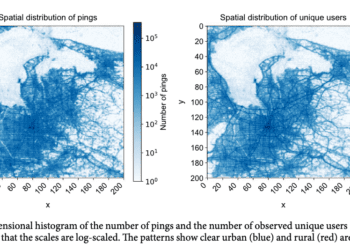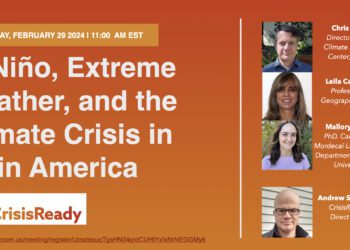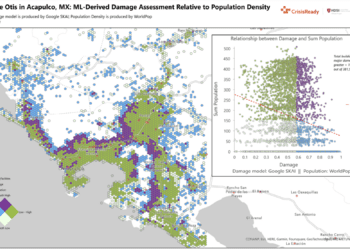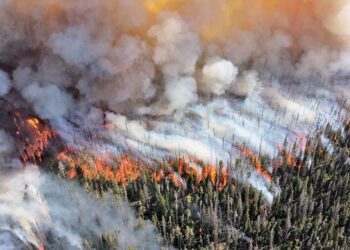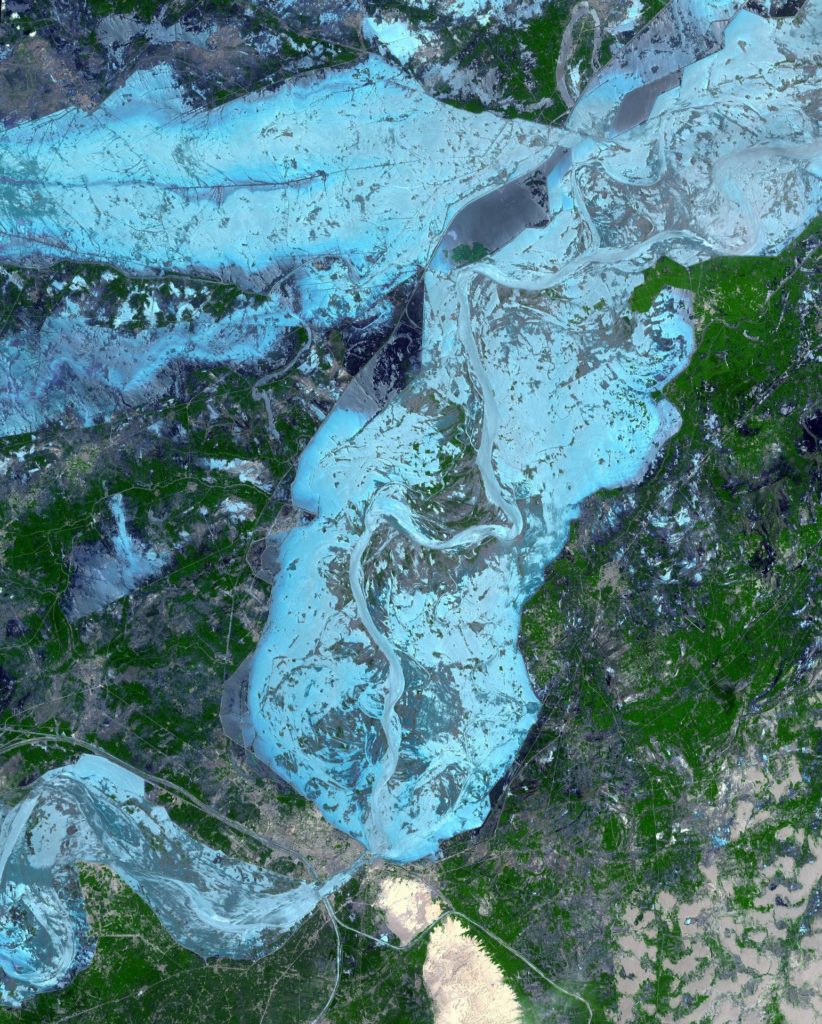
Aerial photographs of the October 2022 Pakistan floods, which were the worst in the country’s history.
The 2022 floods caused widespread damage and displacement in Pakistan, and affected an estimated 33 million people.
Image: NASA

Farmers harvesting rice in a dry field in Cambodia.
Drought is becoming more frequent and severe in Southeast Asia, and it is threatening food security and the regions largest industry — agriculture.
Image: USA Today
Climate Mitigation, Adaptation, and Vulnerability Challenges in Southeast Asia
Over the past ten years, Southeast Asia, a region inhabited by roughly two billion individuals, has encountered a significant number of catastrophic weather events, surpassing the historical frequency of such disasters.
Bangladesh, India, Nepal, and Pakistan have all experienced record-breaking heatwaves, floods, and cyclones that have caused billions of dollars in damage, destruction to critical infrastructure, and negative health impacts for communities in the region.
As climate change increases the frequency and intensity of disasters in South Asia, the most vulnerable populations will be hit the hardest. These individuals often work in informal labor markets, experience food insecurity, and reside in unstable or insecure housing. They are also more susceptible to epidemic infectious diseases, which are known to rise during extreme weather events.
Observations from complex crises around the world show that an overwhelming number of people lack the means to evacuate or find safe refuge during disasters. This issue persists not only in the immediate aftermath of acute disaster events, but also over extended periods of time as the longterm effects of climate change become more evident. These include rising sea levels, coastal saltwater intrusion, and damage to agricultural systems from heatwaves and floods. These impacts continue to put human health at risk long after the disaster takes place.
Climate change mitigation and climate change adaptation are two distinct but interconnected approaches in addressing the challenges posed by climate change. Mitigation focuses on reducing greenhouse gas emissions and minimizing the drivers of climate change to limit its long-term impacts. Adaptation, on the other hand, involves adjusting societal and natural systems to cope with the existing and projected impacts of the climate crisis. Both mitigation and adaptation are crucial elements of comprehensive action to safeguard communities and ecosystems in the face of climate change.
In this post, we take a look back at a previous Data in Crises event, jointly hosted by CrisisReady, the World Bank’s Global Facility for Disaster Reduction and Recovery (GFDRR), Harvard University’s FXB Center for Health and Human Rights, and Harvard University’s Lakshmi Mittal and Family South Asia Institute in December 2022. At the event, we invited speakers from research and response organizations in Bangladesh, India, and the Philippines to share how they are approaching climate adaptation in their respective regions, particularly focusing on the role data plays in decision making processes.
The event aimed to address several critical questions. These included determining the specific information needed for structuring — or restructuring — the operational aspects of using data in response to natural disasters. Additionally, the event aimed to understand what basis relief and response organizations use for setting their priorities, and to identify the types of information required to improve current climate adaptation models. It also sought to evaluate the availability of such information.
While considering these questions, the speakers delved further into the topic, investigating the latest advancements in the field that could advance both scientific research and policy making as it relates to climate adaptation. The speakers also highlighted key areas that warrant greater attention.
Moderator
- Satchit Balsari, Co-Director, CrisisReady; Assistant Professor in the Department of Global Health and Population, Harvard T.H. Chan School of Public Health; Emergency Clinician, Beth Israel Deaconess Medical Center
Speakers
- Liakath Ali, Director, Climate Change Programme & Urban Development Programme, BRAC (Bangladesh)
- Michael Andrew Manalili, GIS Innovation and Development Lead, World Food Programme
- Bhargav Krishna, Fellow, Centre for Policy Research (India)
The session began by addressing the key challenges in climate change adaptation in the region. Each speaker shared the obstacles they faced, relating them to the broader challenges faced by the countries they operate in. This provided insights into the complexities of adaptation in the region, considering factors like limitations in data accessibility, resource constraints, volatile political landscapes, and worsening socio-economic conditions. Understanding these challenges is crucial for shaping future climate change adaptation strategies in Southeast Asia, which in turn can safeguard human health and safety in the region.
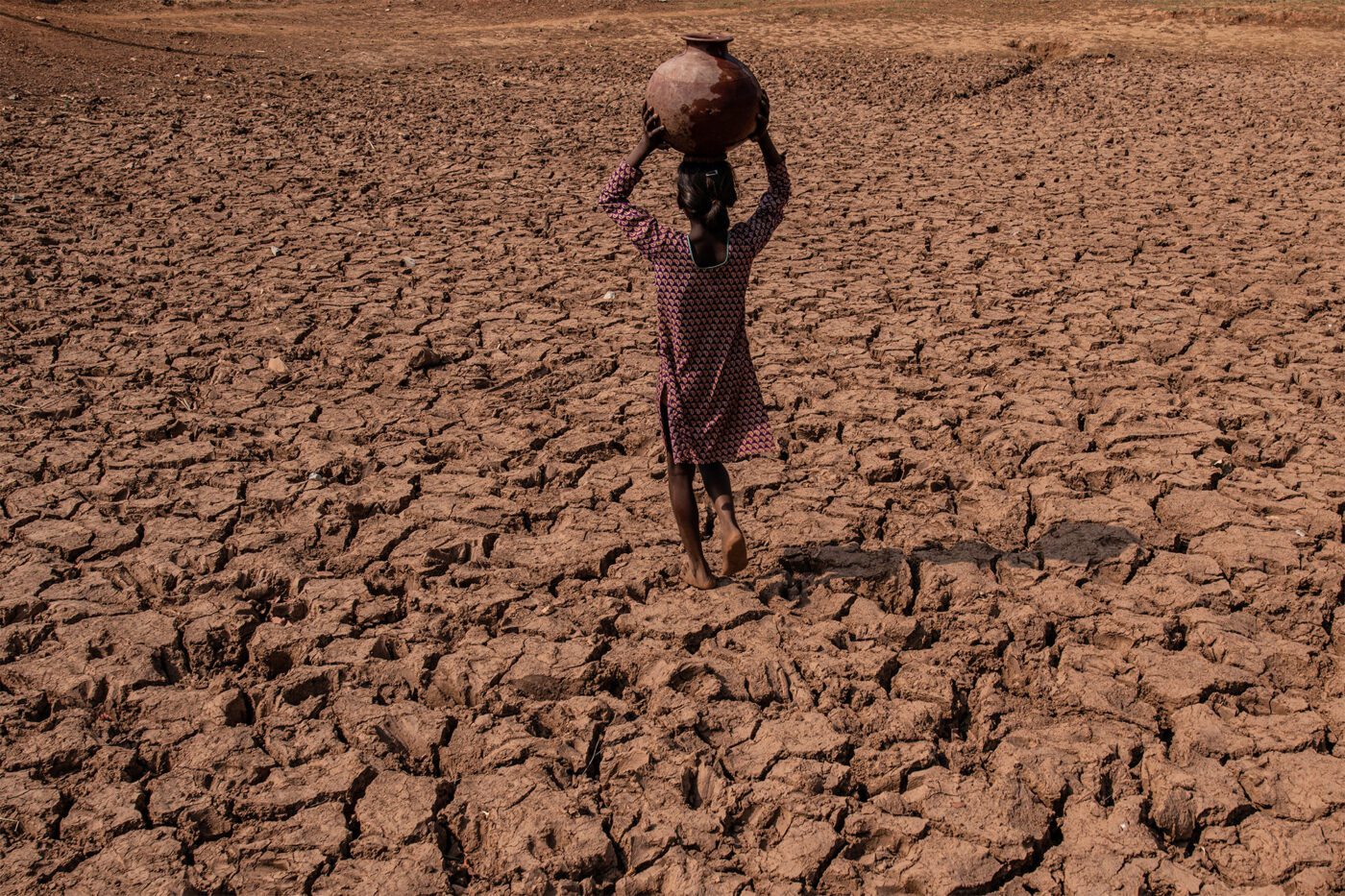
India is one of the most drought-prone countries in the world. Climate change is making droughts more frequent and severe. This is having a devastating impact on agriculture, drinking water supplies, and the economy.
Image: New York Times
Challenges of Climate Adaptation in India
Insights from Bhargav Krishna
In India, the policy and practice of data collection, interpretation, and translation often occur in a reverse manner. Insights from large data sets are retrofitted to support decision making after the data is collected. This leads to several inefficiencies.
Expanding on the point: If insights are only derived after data procurement, the organization is reacting to the data, not proactively seeking answers to key questions or forecasting future scenarios. If the analysis is not designed before the data is gathered, the information collected might lack the necessary context or may not be the most relevant for the decision-making process.
There are several operational inefficiencies that come with this practice. Depending on the volume and variety of the data sets, processing and analyzing them after procurement can be a lengthy process. This can delay decision-making or render some insights obsolete if the situation has changed in the meantime. In addition to this, collecting and storing data without a clear understanding of how it will be used can result in wasted resources.
Improving these processes requires identifying key questions and objectives of the data analysis before procurement begins and enforcing data minimization practices. Employing real-time data analysis techniques and leveraging machine learning and artificial intelligence algorithms to automate processes are also potential solutions. This not only ensures that the analyzed data is relevant to the situation at hand, but addresses the operational constraints by reducing the time it takes to deduce meaningful insights.
Accessing essential data to understand the impacts of climate change is particularly challenging in India. Multiple data sourcing and collection methods are required, which puts a strain on resources and requires negotiation with various state actors for the procurement of relevant data.
Expanding on the point: Gaining access to accurate and up-to-date data on the health impacts related to climate change is essential for effective adaptation planning. The complexity of sourcing relevant data, especially morbidity and mortality data, hampers timely analysis during disasters. These complexities arise from challenges regarding data availability, fragmentation, and interagency coordination.
Securing and improving data sharing agreements between research and response organizations, governmental bodies, and private companies can significantly reduce the challenges associated with procurement and analysis. These agreements can streamline resources by preventing the duplication of efforts, and allowing organizations to share already-collected data instead of multiple entities gathering the same data on their own. This helps prevent resource wastage and inconsistencies. These agreements can also enhance accessibility by standardizing data formats, making it easier for researchers and organizations to put the data to use.
Data that are shared between organizations typically undergo more scrutiny, leading to better data quality through the identification and correction of errors and inconsistencies. This, in turn, accelerates research and promotes the development of comprehensive climate change mitigation and adaptation strategies. Beyond these practical benefits, data sharing agreements foster trust and collaboration among organizations, a vital factor in combating climate change, a challenge too enormous for any single entity to tackle independently.
Organizational workflows and data processing protocols in India are suboptimal, relying heavily on manual entry and analysis methods.
Expanding on the point: Outdated or inefficient data processing practices can lead to delays, errors, and hindered analyses of the data needed for effective climate action. By transitioning to more efficient and automated data entry and analysis methods, organizations can improve the accuracy, speed, and reliability of data processing efforts. This helps to enhance planning, coordination, and decision-making efforts as it pertains to climate adaptation strategies.
Accessing foundational data, such as census or meteorological data which is freely available in other countries, poses significant challenges in the country. The constraints between researchers and the data needed for adaptation models can hinder proactive solutions.
Expanding on the point: Foundational data is an essential resource for understanding climate impacts and informing adaptation strategies. The challenges in procuring census and meteorological data in India often hinders comprehensive analyses and can impede the development of proactive adaptation solutions.
In order to address these challenges, not only should methods of data sharing be improved, but data infrastructure should be improved, overall. Promoting open data policies to facilitate effective climate adaptation planning in India could help solve this critical issue.
As one might expect, open data policies make it easier for researchers and policymakers to access foundational information, including census and meteorological data. This is because open data is typically published online and is free to use. This makes it easier for researchers to find the data they need to conduct relevant research and makes it easier for policymakers to use data to develop adaptation plans.
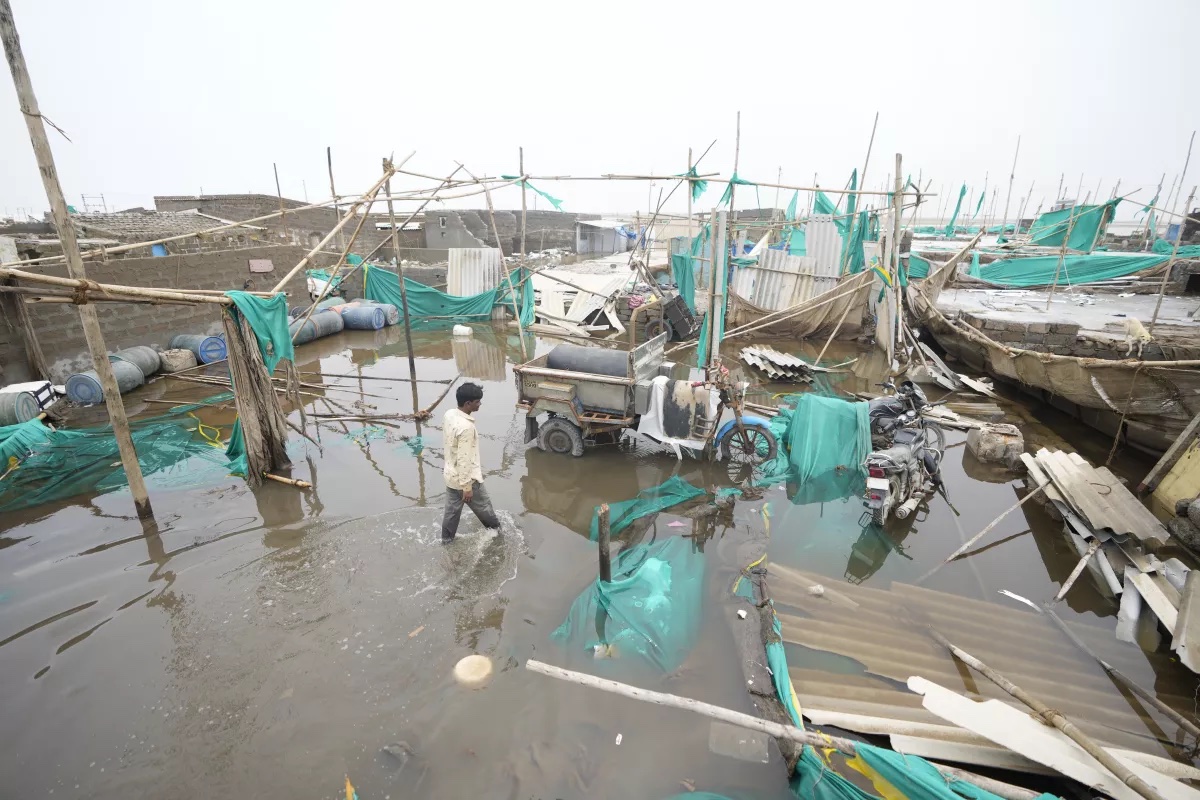
A neighborhood flooded by Cyclone Biparjoy, which struck India and Pakistan in June 2023.
Tropical storms are becoming more prevalent in Southeast Asia, making the destruction of homes, communication and transportation networks, and power grids more common.
Image: VOA News

Residents fill water from a Delhi Municipal Corp. truck in New Delhi in April 2022, during a record-breaking heatwave in the country.
Image: Anindito Mukherjee/Bloomberg
As previously mentioned in the context of cross-organizational collaboration efforts, open data policies can help to improve the quality of data because they are more exposed to critical evaluation than closed or private data. This is because it is accessible to a wider range of people and because it is more likely to be used by people who have a vested interest in the data. This scrutiny can help to ensure that open data is of high quality and that it is used in a responsible way.
Open data policies, by publishing free-to-view data online, can also enhance transparency, build trust, and promote responsible data usage.
Challenges of Climate Adaptation in Bangladesh
Insights from Liakath Ali
Limited data accessibility hinders tracking climate-induced migration and understanding its impacts in Bangladesh. To overcome this challenge, it is essential to foster collaboration with city authorities and government bodies, allowing for improved data collection and analysis.
Expanding on the point: Climate-induced migration can have significant social, economic, and environmental implications. Similarly to designing effective adaptation strategies, access to comprehensive and reliable data is crucial for understanding the patterns, drivers, and consequences of migration in the context of climate change.
By working closely with local authorities and governmental agencies, better data collection mechanisms can be established to better inform adaptation strategies. Securing these partnerships can also help response organizations build the capacity of local and city authorities to collect and manage data on climate-induced migration and displacement by providing training on data collection and management, and by providing access to technical resources.
In addition to advocating for open data sharing policies, working alongside local authorities can enhance interagency coordination, improve efficiency of research and response, and inform decision making as it pertains to forced migration and displacement.

Climate change is causing Bangladesh to experience more frequent and severe flooding, which is displacing millions of people and causing widespread damage to infrastructure.
Image: CNN

People wade through the water as they look for shelter during a flood in northeastern Bangladesh.
Floods devastated Bangladesh and India in June 2022, affecting an estimated 7.2 million people and causing critical damage to infrastructure.
Image: Reuters/Abdul Goni

Landslides in Rangamati and Khagrachhari, Bangladesh killed at least 17 people and injured over 100 in May 2022.
The landslides were caused by heavy rains that caused the ground to become unstable
Image: The Atlantic via Reuters TV / Reuters
Establishing a common framework is necessary to effectively implement and translate data into Bangladesh’s adaptation efforts, especially when incorporating local knowledge, insights, experiences, and socio-economic data.
Expanding on the point: Successful climate adaptation requires the integration of diverse perspectives, including scientific data and local knowledge. However, the challenge lies in harmonizing these different sources of information and ensuring they inform cohesive and coordinated strategies.
Developing a shared framework that facilitates the integration, analysis, and application of data from various sources can not only establish a broader understanding of climate change and its effects on communities, but can enhance the effectiveness and relevance of national adaptation efforts altogether. A shared framework can help to ensure that adaptation strategies are targeted to the specific needs of different communities. This can be done by analyzing data to identify the most vulnerable communities and the most pressing adaptation needs. By targeting adaptation strategies, Bangladesh can ensure that resources are used in the most effective way possible.
Establishing a shared framework for all phases of the data analysis process can also increase coordination between different stakeholders involved in decision making. A shared framework allows data to be readily accessible to the public, and thus ensures that adaptation strategies are developed in a participatory way. By increasing transparency and accountability in this way, Bangladesh can build trust with the public and ensure that adaptation efforts are effective.
Integrating scientific data with local insights presents a significant challenge in climate adaptation endeavors.
Expanding on the point: Bangladesh is a developing country with limited resources, meaning there is often a lack of baseline scientific data on the impacts of climate change. As such, developing effective adaptation strategies in the country is already a difficult task, and the integration of local, contextual knowledge further heightens this challenge.
Even when data is available, it is often not accessible to local communities. This is because data is often stored in inaccessible formats or is not available in local languages. On top of this, scientific data and local insights often have different understandings of climate change. This can make it difficult to integrate the two sources of information
Compounding challenges are issues of trust between scientific experts and local communities and the difficulties in communication that arise between the two groups. Political, economic, and social contexts heighten these challenges even more.
For Bangladesh to successfully integrate scientific data with local insights, several strategies need to be employed. First, enhancing local agencies data management skills through capacity building, and engaging them in data collection and interpretation aids in bridging some of the existing gaps. Fostering trust is also key, which can be achieved through collaborative initiatives and transparent communication about research objectives and methodologies, and their potential impacts on local communities. Clarity about climate change issues and their specific relevance to local communities can further contribute to addressing this challenge.

The Philippines is one of the most vulnerable countries to climate change. The country is located in a typhoon-prone region, and it is also affected by rising sea levels. Climate change is already having a significant impact on the Philippines, and it is expected to get worse in the years to come.
Image: Newsweek
Challenges of Climate Adaptation in the Philippines
Insights from Michael Andrew Manalili
Utilizing local knowledge to interpolate adaptation models poses challenges. Incorporating the wealth of local wisdom, traditional practices, and indigenous knowledge into adaptation strategies requires effective integration methods to ensure their relevance and applicability.
Expanding on the point: As is true in Bangladesh and many other parts of the world, local communities possess valuable knowledge and insights about their environment and vulnerabilities. The challenge lies in bridging the gap between scientific models and local knowledge systems to develop adaptation approaches that are contextually appropriate and effective.
There are a few ways to bridge the gap between scientific models and local knowledge systems. One way is to involve local communities in the development of climate change adaptation strategies. This could be achieved by conducting participatory research, where local communities contribute to the collection and analysis of data. It can also be done by creating community-based adaptation plans, where local communities are involved in the development of adaptation strategies that are tailored to their specific needs.
Another way to bridge the gap between scientific models and local knowledge systems is to develop tools that can help to integrate both approaches. For example, there are a number of software tools that can be used to combine scientific data with local knowledge. These tools can help to identify areas that are most vulnerable to climate change, and they can help to develop adaptation strategies that are tailored to the specific needs of local communities.
In the Philippines, local communities have already developed a number of traditional flood management techniques, such as building embankments and raising houses on stilts. These techniques have helped to reduce the impact of floods on local communities. Understanding the ways these communities respond to climate-related disasters on their own can help researchers and response agencies better design and implement effective policy.
The applicability of highly accurate AI predictive models is inconsistent and often fails to cater to the specific needs of local communities. While AI models may yield precise predictions, their practical usefulness in addressing local climate challenges remains limited.
Expanding on the point: AI models often rely on extensive data inputs and may not adequately capture the localized nuances, socioeconomic factors, or unique environmental conditions that shape climate impacts. Balancing the strengths of AI models with the specific needs and realities of local communities is essential for effective climate adaptation, especially in resource-constrained regions like the Philippines.
AI holds significant potential to enhance climate change adaptation in the country. It can be particularly useful in identifying areas most vulnerable to climate change impacts, developing strategies that are tailored to the specific needs of local communities, and monitoring the efficacy of these strategies. However, if the data employed in the models is not representative of the local context, the results may be misleading.
It is also important to ensure that new AI models are used in a way that is transparent. The results of these models should be made available to local communities so that they can understand how the models work and how the results can be used to inform adaptation planning.
Despite some of the challenges of using AI in climate action, new models are currently being deployed to address some of the most pressing climate impacts affecting the Philippines. The Philippine government, for example, is using AI models to identify areas that are most vulnerable to flooding, which have become much more common in recent years. This information is being used to help communities develop proactive adaptation plans. The World Bank is using advanced algorithms to develop adaptation strategies for farmers in the country, and the models are being used to simulate the impact of different strategies on crop yields. In addition to these examples, The University of the Philippines is using new AI models to monitor the effectiveness of the country’s current adaptation strategies, ensuring they are achieving the desired outcomes and addressing the most urgent needs.
The region faces challenges in AI readiness, particularly in the development of AI programs for climate adaptation. Leveraging the benefits and acknowledging the limitations of predictive AI models is crucial, as it can be challenging to discern accurate and reliable predictions regarding climate impacts on the ground.
Expanding on the point: Despite the vast potential of AI previously stated, developing effective programs that utilize these new technologies requires consideration of the region’s specific contextual factors, data availability, and technical capabilities. Clearly defining the scope, uses, and limitations of AI algorithms is vital for response agencies and communities to understand how to utilize and interpret AI-generated information in their operations effectively.
Aside from the work being conducted at the University of the Philippines and the Philippine government, there is generally a lack of investment in AI research and development in the country. There is also a lack of skilled AI talent and a lack of awareness about the potential of AI for climate change adaptation. The Philippines also faces considerable challenges in data collection and access, which has limited the country’s ability to develop AI models that are accurate and relevant to the local context.
Initiatives are underway to improve AI readiness and expertise in the country, offering hope that innovative technologies and AI algorithms can contribute positively to national objectives. The Department of Science and Technology launched the Philippine AI for Social Good Program, which promotes the use of AI for societal benefits, including climate change adaptation. Moreover, as previously discussed, The AI for Climate Change Adaptation Initiative by the World Bank is enhancing capacities in developing nations, aiming to further the application of AI in climate impact mitigation and adaptation.
The Road Ahead for Climate Adaptation in Southeast Asia
Climate change is already having a devastating impact on Southeast Asia, and the severity and frequency of destructive natural disasters are only going to increase in the years to come. This is especially true in the countries examined in this article, where large populations are already facing a number of immediate and long-term impacts of climate-related disasters.
In order to protect these communities, it is important to support both climate adaptation efforts and the vulnerable people they aim to serve, whether that be socially, economically, physically, or in terms of infrastructure. These communities are often the least able to cope with the effects of climate change, and they need greater assistance to adapt to the changing climate. Fortunately, there is a lot of work being done to support climate adaptation efforts throughout Southeast Asia, both locally and internationally.
CrisisReady Co-Directors Dr. Caroline Buckee and Dr. Satchit Balsari are leading a research initiative with Harvard University’s Salata Institute for Climate and Sustainability. This initiative is studying the changing climate in South Asia and the threat it poses to agricultural systems, food security, and human health in the region. As the Principal Investigator of the research Cluster, Dr. Buckee is collaborating with in-region partners to ensure that local concerns are taken into account when setting goals and developing a shared scientific vision. These partners include international agencies, such as BRAC in Bangladesh and the Self-Employed Women’s Association (SEWA) in India.
These partnerships will ensure that adaptation planning is driven by the voices and concerns of the region’s vast labor force, which primarily works in the informal economy. This includes daily wage earners, farmhands, street vendors, construction workers, and more.
In addition to this, CrisisReady is launching a new initiative called Climateverse to better leverage existing climate data in South Asia. The platform will offer processed, organized, and easy-to-use data for researchers and policymakers to simplify the data discovery process and make it more relevant. Climateverse will also allow users to pull specific climate-related information through simple, conversational queries.
The team hopes that Climateverse will address the challenges outlined earlier in this article, especially those related to data accessibility, procurement, and management. For example, the platform will make it easier for users to find the data they need, and it will also provide guidance on how to use the data effectively.
Climateverse is still in development, but it has the potential to make a significant impact on climate adaptation efforts in South Asia. By making climate data more accessible and easier to use, the platform can help researchers and policymakers develop more effective adaptation strategies.
